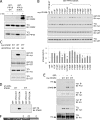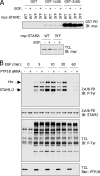PTP1B targets the endosomal sorting machinery: dephosphorylation of regulatory sites on the endosomal sorting complex required for transport component STAM2
- PMID: 20504764
- PMCID: PMC2911340
- DOI: 10.1074/jbc.M110.115295
PTP1B targets the endosomal sorting machinery: dephosphorylation of regulatory sites on the endosomal sorting complex required for transport component STAM2
Abstract
Dephosphorylation and endocytic down-regulation are distinct processes that together control the signaling output of a variety of receptor tyrosine kinases (RTKs). PTP1B can directly dephosphorylate several RTKs, but it can also promote activation of downstream pathways through largely unknown mechanisms. These positive signaling functions likely contribute to the tumor-promoting effect of PTP1B in mouse cancer models. Here, we have identified STAM2, an endosomal protein involved in sorting activated RTKs for lysosomal degradation, as a substrate of PTP1B. PTP1B interacts with STAM2 at defined phosphotyrosine sites, and knockdown of PTP1B expression augments STAM2 phosphorylation. Intriguingly, manipulating the expression and phosphorylation state of STAM2 did not have a general effect on epidermal growth factor (EGF)-induced EGF receptor trafficking, degradation, or signaling. Instead, phosphorylated STAM2 specifically suppressed Akt activation, and a phosphorylation-deficient STAM2 mutant displayed prolonged localization on endosomes following EGF stimulation. These results reveal a novel link between the dephosphorylation and endocytic machinery and suggest that PTP1B can affect RTK signaling in a previously unrecognized manner.
Figures



Similar articles
-
Protein-tyrosine phosphatase 1B modulates early endosome fusion and trafficking of Met and epidermal growth factor receptors.J Biol Chem. 2011 Dec 30;286(52):45000-13. doi: 10.1074/jbc.M111.270934. Epub 2011 Nov 1. J Biol Chem. 2011. PMID: 22045810 Free PMC article.
-
In control at the ER: PTP1B and the down-regulation of RTKs by dephosphorylation and endocytosis.Trends Cell Biol. 2010 Nov;20(11):672-9. doi: 10.1016/j.tcb.2010.08.013. Epub 2010 Sep 23. Trends Cell Biol. 2010. PMID: 20864346 Review.
-
Identification of a novel immunoreceptor tyrosine-based activation motif-containing molecule, STAM2, by mass spectrometry and its involvement in growth factor and cytokine receptor signaling pathways.J Biol Chem. 2000 Dec 8;275(49):38633-9. doi: 10.1074/jbc.M007849200. J Biol Chem. 2000. PMID: 10993906
-
Rin1 interacts with signal-transducing adaptor molecule (STAM) and mediates epidermal growth factor receptor trafficking and degradation.J Biol Chem. 2007 May 18;282(20):15294-301. doi: 10.1074/jbc.M611538200. Epub 2007 Apr 2. J Biol Chem. 2007. PMID: 17403676
-
Roles for ER:endosome membrane contact sites in ligand-stimulated intraluminal vesicle formation.Biochem Soc Trans. 2018 Oct 19;46(5):1055-1062. doi: 10.1042/BST20170432. Epub 2018 Sep 20. Biochem Soc Trans. 2018. PMID: 30242114 Free PMC article. Review.
Cited by
-
Reversible phase separation of ESCRT protein ALIX through tyrosine phosphorylation.Sci Adv. 2023 Jul 14;9(28):eadg3913. doi: 10.1126/sciadv.adg3913. Epub 2023 Jul 14. Sci Adv. 2023. PMID: 37450591 Free PMC article.
-
Integrated analysis of proteome, phosphotyrosine-proteome, tyrosine-kinome, and tyrosine-phosphatome in acute myeloid leukemia.Proteomics. 2017 Mar;17(6):10.1002/pmic.201600361. doi: 10.1002/pmic.201600361. Proteomics. 2017. PMID: 28176486 Free PMC article.
-
Regulation of signaling at regions of cell-cell contact by endoplasmic reticulum-bound protein-tyrosine phosphatase 1B.PLoS One. 2012;7(5):e36633. doi: 10.1371/journal.pone.0036633. Epub 2012 May 24. PLoS One. 2012. PMID: 22655028 Free PMC article.
-
Annexin A1 Tethers Membrane Contact Sites that Mediate ER to Endosome Cholesterol Transport.Dev Cell. 2016 Jun 6;37(5):473-83. doi: 10.1016/j.devcel.2016.05.005. Dev Cell. 2016. PMID: 27270042 Free PMC article.
-
Protein-tyrosine phosphatase 1B modulates early endosome fusion and trafficking of Met and epidermal growth factor receptors.J Biol Chem. 2011 Dec 30;286(52):45000-13. doi: 10.1074/jbc.M111.270934. Epub 2011 Nov 1. J Biol Chem. 2011. PMID: 22045810 Free PMC article.
References
-
- Dikic I., Giordano S. (2003) Curr. Opin. Cell Biol. 15, 128–135 - PubMed
-
- Peschard P., Park M. (2007) Oncogene 26, 1276–1285 - PubMed
-
- Abella J. V., Park M. (2009) Am. J. Physiol. Endocrinol. Metab. 296, E973–E984 - PubMed
-
- Ostman A., Hellberg C., Böhmer F. D. (2006) Nat. Rev. Cancer 6, 307–320 - PubMed
Publication types
MeSH terms
Substances
Grants and funding
LinkOut - more resources
Full Text Sources
Miscellaneous

